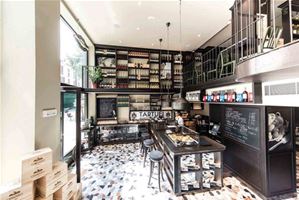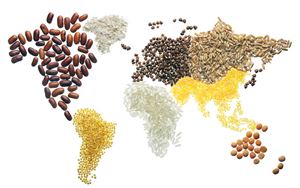Many cities around the world have been designed or redesigned to include sufficient green areas to provide beauty, relaxation and recreation, increasing living standards for all residents, especially children. Florence, however, is not a city for nature lovers and green thumbs. The city and its narrow winding streets were made to ward off medieval invaders, not for comfortable 21st-century urban living. Over the years, Florence has been cited for its high levels of pollution, largely caused by an unsustainable number of motor vehicles on the road (see ‘Smog’ in TF 119). This reality has pushed many to rethink the city’s green strategy. One local resident, Giacomo Salizzoni, a landscape architect and guerrilla gardener, and his wife, Miami-born yoga instructor Melissa Ferrer, have taken things one step further. Salizzoni is one of Florence’s most active guerrilla gardeners and green advocates.
Since the birth of our child, our project to create a community garden and urban farm has become of utmost importance,’ he says. ‘We want to create a space, a community garden, where local residents can gather and sow seeds together, where they can cook the vegetables they have grown; where they can also cultivate a sense of community and belonging.’ What is community gardening and how did start? Is there a place in Florence for it? Salizzoni helped TF answers these questions when we spoke with him about his hopes for an urban farming revolution in the city.
WHAT IS GUERRILLA GARDENING?
The green ‘attacks’ by guerrilla gardeners are meant to challenge access to urban spaces and improve the condition of land sooner than bureaucracy does. Often in secrecy, guerrilla gardeners take possession of these lands to plant flower gardens or cultivate vegetables. It is considered a form of ‘pro-activism’ intended to provoke change from the bottom up. It can be a political gesture, which is usually a one-shot attack with seed bombs, or one that has a genuine horticultural goal to fulfill, that of being legitimized by the property’s owner.
According to Wikipedia, ‘guerrilla gardening’ is ‘gardening on another person’s land without permission.’ It is the illicit act of ‘reclaiming land from perceived neglect or misuse and assign a new purpose to it.’
WHAT ARE ‘SEED BOMBS’?
Seed bombs are an easy way to distribute seeds in derelict and abandoned areas that you want to beautify with plants and flowers. The seeds are encased in a mixture of clay and compost, which protects the seeds by preventing them from drying out in the sun, getting eaten by birds, or being blown away by the wind. Seed bombing is relatively easy: seed bombs are scattered directly on the ground in spring and left there to grow on their own. Sufficient rain will permeate the clay, and the seeds inside will begin to sprout aided by the nutrients and soil microbes surrounding them. This method has been used in gardening for centuries but has only taken on political significance in the twentieth century. In fact, seed bombs were used by the North American First Nations’ tribes to sow the land.
WHAT IS A COMMUNITY GARDEN?
A form of urban gardening, community gardens are legitimate spaces where members of the local community can cultivate vegetables or grow and maintain flower gardens. These gardens are usually managed by a nonprofit organization with the approval of local government or the land’s owner. Over the years, community gardens have mushroomed in cities across northern Italy. For example, Milan and Turin already count more than 100 community gardens, where residents meet to garden, beautify their surroundings and cultivate connections with each other and their environment.
‘A community garden is a single piece of land gardened collectively by a group of people … Community gardens provide fresh produce and plants as well as satisfying labor, neighbourhood improvement, sense of community and connection to the environment,’ also in Wikipedia.
WHAT IS A CONTAINER GARDEN?
Containers, usually used for growing flowers and houseplants in and outside the home, can also be used to grow vegetables in very dry areas or where the soil is unsuitable for cultivation of edible plants. We aksed Salizzoni to explain his project and the use of container gardens to grow vegetables.
GS: My idea for container gardening involves about 50 or so simple containers from Ikea. The urban garden I have planned is not fixed and permanent but instead portable. I have designed it this way for several reasons. First, because the city’s piazzas are also used for events and social aggregation and an urban garden shouldn’t damage these important social functions. Second, my project is also an education one, aimed at raising public awareness about the importance of gardening and its role in maintaining the local ecosystem, teaching respect for the environment, and the need for green areas in the city where people can aggregate and work together. It’s also fun to teach people to grow their own food! In addition, a portable vegetable garden can adapt to any urban setting without changing it.
HOW CAN VEGETABLES GROW IN CONTAINERS?
GS: The plastic containers from Ikea are perfect to create a sub-irrigation system. Much more effective than top-watered cultivation is bottom-water cultivation obtained through the sub-irrigation system. You could do the same with the more traditional raised bed planter in wood or plastic, but these are not portable.
The containers are almost like gardening in raised beds, which are more accessible for children, the disabled and the elderly. The cost of maintaining this kind of portable container garden is very low. We could even make our own compost in another container with kitchen scraps and other organic materials.
AREN’T IN-GROUND BEDS BETTER FOR VEGETABLE GARDENS?
GS: For now we are concentrating on the portable gardens, but eventually we’d also like to find a permanent space for traditional in-ground gardening. I envision that this area would also feature a small building with a kitchen where community members could cook together the foods they grow together. There would be an area, whether privately onwed or the property of the city, where kids can play and take part in educational activities and workshops and where community members can just hang out.
IS THE CITY OF FLORENCE INTERESTED IN SUCH A PROJECT?
GS: Yes. I’m currently in talks with city officials and they seem enthusiastic about the portable garden project. Possible locations include the piazza on via dell’Agnolo and the green areas in via Maragliano and piazza Tasso. We are excited about the city’s openness to the project and this issue. But the most important thing now is to gather interested gardeners.
Salizzoni’s project and an explanation on how the sub-irrigation planters work is available at www.guerrillagardener.it. He and his wife Melissa have organized a community meeting on March 30 at 7pm at the It’s Yoga Firenze studio, on via de’ Bardi 21, for anyone who is interested in participating in community gardening. The aim is to create a network of volunteer city gardeners to help set up the first urban community vegetable garden in the city. For more information, email gsalizzoni@gmail.com or itsyogafirenze@gmail.com.







